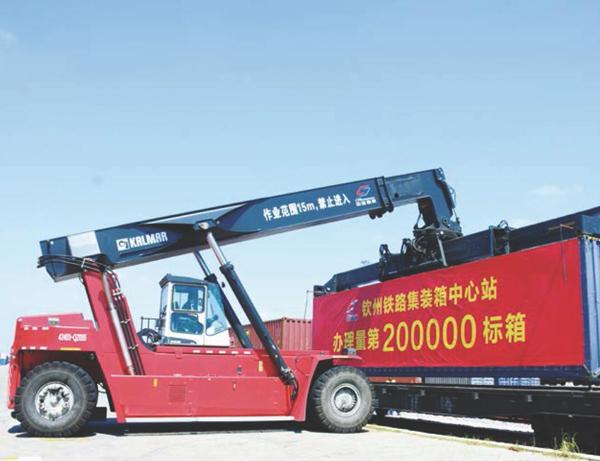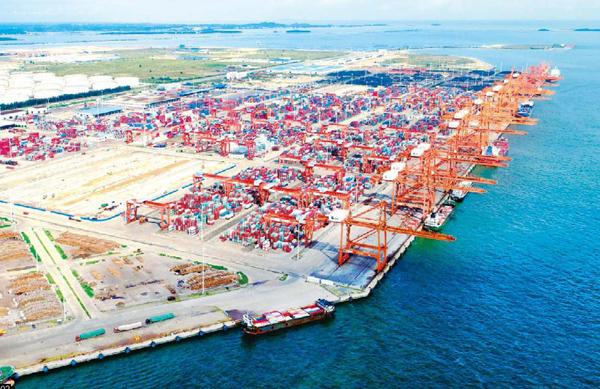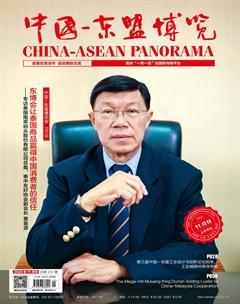钦州港片区:以新突破、高增幅为“陆海新通道”建设添彩
黄昀昀


得益于國际陆海贸易新通道(以下简称“陆海新通道”)的发展,“海铁联运”成为中国(广西)自由贸易试验区钦州港片区(以下简称钦州港片区)的一大亮点,钦州铁路集装箱中心站在其中起到“联”的作用。在今年中国港口货量有所下降的情况下,该中心站仍一次又一次地创下集装箱办理量佳绩。
钦州港的优异成绩单
2020年10月8日,一辆满载2962吨大豆、玉米的列车从钦州铁路集装箱中心站驶往昆明宜良北站,标志着“陆海新通道”(钦州港)集装箱办理量突破20万标箱,同比增幅达110%。据中铁联合国际集装箱广西有限公司副总经理王铁成介绍,目前该中心站日均集装箱办理量在900~1000标箱之间,和2019年同期相比,大约增长109%。该中心站在中国铁路12个中心站中发送箱量排名第五位,办理量排名第八位。
据了解,2019年6月30日,钦州铁路集装箱中心站港口作业区正式开通运营。一年多以来,该中心站集装箱办理量节节高升。截至2020年8月1日,其办理量就已达到14万标箱,仅用7个月的时间就超越了2019年全年办理量。
该中心站作为目前中国最晚投入使用的中心站,是如何在疫情夹击中利用后发优势,乘胜追击的?王铁成给出了答案:这段时间里,该中心站主要从三个方面来保证货源的充足和高效的作业。“首先,我们积极与重庆、成都、昆明几个中心站联系,加开点对点集装箱班列。其次,在中国铁路南宁局集团有限公司、广西沿海铁路股份有限公司的调度指挥下,我们加快装、卸、排作业组织,提高场站的工作效率。最后,我们通过为客户提供更优质的服务,引入更多的货源。”他说。
王铁成对中心站的发展前景充满信心,这主要是因为该中心站处于钦州港片区,是“陆海新通道”海铁联运的重要节点,承担着货物中转的重要功能。他表示:“货物可以通过我们这里发往全球。如可利用中欧班列,进入欧洲市场。利用21世纪海上丝绸之路,前往东南亚、非洲等地。”
“智慧港口”引领着未来运输发展的新潮。近年来,各大港口都在热火朝天地就该领域进行建设。钦州铁路集装箱中心站要成为后起之秀,自然也将打造智慧港口新模式看作工作的重中之重。王铁成说,该中心站正处于过渡期,尚使用有人驾驶的集装箱正面起重机进行作业。但预计2020年底,将完成6台龙门吊的主体框架搭建工作,2021年6月30日前完成全部测试并投入使用。“届时,这一中心站将变为全自动化、无人值守的场站,通过电脑来进行集装箱的装卸作业,这将极大提高运输效率,大大节约人力成本,还能充分保障员工的人身安全。”
钦州港片区希望靠海,潜力靠海
产业发展和物流的畅通密不可分,王铁成认为,该中心站的发展对钦州港片区经济的促进作用十分明显。其一,物流的便利性和优惠性有利于形成产业集聚效应。其二,就物流本身而言,海铁联运也能为钦州港片区经济效益的上升提供直接助力。而2019年,西部陆海新通道上升为中国国家战略,更是将钦州港片区置于聚光灯下。
为打造开放新高地,钦州港片区抢抓机遇,积极对标国内国际一流港口,加快港口硬联通和软联通建设,强化海铁联运,加密航班航线,加快推进国际门户港建设。经过一年的努力,钦州港片区建成钦州港东航道扩建二期工程等系列重大港口基础设施项目。截至2020年9月,钦州港已建成8个10万吨级集装箱泊位,开通集装箱航线49条,基本实现了中国和东盟国家主要港口全覆盖。2020年1~9月,钦州港累计完成港口货物吞吐量7591.26万吨,同比增长23.54%;集装箱吞吐量完成269.96万标箱,同比增长32.62%,在全国港口航运普遍低迷的情况下率先逆势实现双增长。
在服务模式方面,钦州港片区紧盯海铁联运“最后一公里”、集装箱全生命周期管理、通关监管服务、提效降费等重点环节,全力推动以海铁联运“一单制”“一口价”“一箱到底”“国际中转集拼便利化”等为重点的国际门户港服务模式创新,进一步促进提效降费。目前,钦州港进口整体通关时间比2019年压缩54.13%,出口整体通关时间压缩87.81%,大大节省了企业的时间成本。
对于未来的计划,中国(广西)自由贸易试验区钦州港片区管委会、中马钦州产业园区管委会副主任莫福文表示:“推进‘陆海新通道建设是钦州港片区一项重要的工作内容,在抓好千亿级绿色化工项目落地的同时,钦州港片区将充分发挥‘陆海新通道在西部地区连接‘一带和‘一路的枢纽作用,积极推进中马‘两国双园升级版建设。在投资与贸易便利化背景下,不断深化陆海双向开放,全力打造具有中国—东盟特色的向海经济集聚区,促进钦州港片区高水平、高质量发展,为‘陆海新通道建设赋予新的内涵。”
·资料来源:防城港人民政府门户网站、防城港发布、中国日报、广西日报
When a recession hits, economies tend to become more protective by putting up trade barriers. But that isnt an advisable option for trade-dependent Southeast Asia. If anything, now is the time for ASEAN members to open up further by joining multilateral trade deals such as the Comprehensive and Progressive Agreement for Trans-Pacific Partnership (CPTPP) and the Regional Comprehensive Economic Partnership (RCEP).
As Southeast Asia cautiously emerges from lockdown, the policy focus is shifting from triage to kick-starting their economies. In its June forecast, the IMF estimated that Southeast Asias five biggest economies will shrink by 2% in 2020, which is better than the global average of -5%, but it will still be a severe shock for a region that has experienced growth every year since the 1960s.
Rebuilding Southeast Asias growth engine will be a challenge. The regions Big Three trade sectors — commodities, electronics and textiles — all face economic uncertainty as demand stalls. And investment, which has historically been an important economic growth driver, is set to fall dramatically across Southeast Asia, stunting the regions manufacturing growth.
The temptation at times of global economic uncertainty is to pull up the drawbridge and try to isolate the economy. Even before the COVID-19, there is evidence that Southeast Asia was retreating from internationalism as the global economy wobbled. In April 2019, the European Union-ASEAN Business Council estimated that the 10 members of the Association of Southeast Asian Nations had imposed some 6,000 separate non-tariff barriers to trade across the region.
But giving in to the temptation of more protectionism would be a mistake. Barriers built in an attempt to isolate an economy from uncertainty have a tendency to become barriers to growth.
Recovery from the pandemic is a challenge, but it is also an opportunity for a policy reset: a new chance to create a transparent, coordinated and low-tariff trade environment which facilitates short-term recovery and sets the stage for long-term prosperity.
The key lies in free trade agreements, specifically the RCEP and the CPTPP.
RCEP accounts for 30% of the worlds population and 29 of global gross domestic product. CPTPP is a comprehensive, high-standard regional free-trade pact which brings together 11 economies from both sides of the Pacific, representing a little under 14% of the global economy.
At a time of increased protectionism and economic headwinds, these agreements promise to open the door to a new era of trade and investment integration and certainty between nations, maintain a rules-based order, and create a level playing field for large and small countries.
RCEP — which includes the ten ASEAN nations, China, Japan, South Korea, Australia and New Zealand — is reportedly down to the “last mile” details after almost a decade of negotiations. Obviously, a finalized RCEP agreement will be a welcome and timely economic boost for businesses seeking to offset the impact of the coronavirus outbreak. HSBC encourages ASEAN members to conclude these negotiations ahead of the RCEP summit later this year. RCEP members also have explicitly stated that they will “leave the door open” for India to rejoin.
FTAs can also create a hedge for Southeast Asian markets who may otherwise be exposed and vulnerable to trade barriers from traditional trade partners.
Thailand, Indonesia and the Philippines have been weighing up the cost and rewards of joining Singapore, Malaysia, Vietnam and Brunei in the CPTPP. But with global economic prospects not as bright as they were nine months ago, these markets may need to choose pragmatism over perfection when assessing the viability of CPTPP. The risks of missing out may prove costly.
Regional FTAs like RCEP and CPTPP are also driving important domestic regulatory reforms, including in areas like labor laws (links to labor productivity), investment liberalization, cybersecurity, cross-border data rules and intellectual property protection. These reforms create less visible but material commercial incentives for trade and investment from member partners. This is only going to accelerate as we see supply chain dynamics change.
For example, HSBCs July 2020 Navigator research found that companies are seeking greater control, transparency and confidence in their supply chain production. Suppliers that can offer assurances that come under an FTA framework could find themselves with a competitive edge.
This scenario could very well be applied to Southeast Asias electronics manufacturing ecosystem. Currently Malaysia, the Philippines, Vietnam, and Thailand all vie for the lower-value electronics assembly. As producers begin to revisit their supply chain locations, in this COVID-19 environment, future locations could be selected based on which countries provide the most attractive “pull” factors.
Of course, completing an FTA does not happen overnight largely because these agreements are complex and have knock-on implications for domestic economies.
Achieving success will require these Southeast Asian governments to deliver strong and compelling messages to their constituents about the benefits that these agreements will bring. They will also need to complement trade policy with domestic programs aimed at re-skilling or redeploying workers who may be adversely affected by increased foreign competition.
While it may seem counterintuitive, the current challenging economic outlook could actually be the perfect time for Southeast Asian countries to make strong and far-reaching economic and trade policy actions such as finalizing the RCEP or joining the CPTPP. In more precarious times, such as we have now, the choice is made clearer: Either we recognize, accept and embrace change and put ourselves in a position to seize opportunities, or we face being left behind.
· Source: The Jakarta Post

